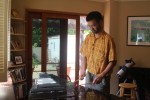Michael Chwe walks into his garden on a bright midsummer morningand dons a smock made out of a black trash bag. He covers his eyes with a translucent plastic mask and places a respirator over his nose and mouth. He is ready to get to work.
Using a tile cutter, he slices granite floor tiles into strips for his newest instrument – the whirring and buzzing of the machine silenced by his oversized blue headphones.
But the instrument, called a lithophone, is not new at all. In fact, these rock marimbas have existed for thousands of years.
“Lithophones may be the oldest instruments,” said Chwe, a game theory and political science professor. “But (they aren’t) something you’d necessarily think of as an instrument.”
Chwe began creating lithophones more than two years ago. Lithophones are large xylophone-like instruments traditionally made of stone, though Chwe chose to cut granite floor tiles for his project because of their uniform length and thickness. The standard size of the tiles makes tuning each piece of the instrument easier, though he still struggles with the lower notes, he said. It takes him about two to three days, 12 hours in total, to complete a new lithophone.
Among his many fields of expertise, Chwe has always been musical. He played the violin growing up and joined an a cappella group in college, he said.
“Music is individual and social, and you can do it until you’re very old,” Chwe said. “It’s very stimulating to the mind.”
Chwe’s children have a passion for music as well. One of the rooms in his house is filled entirely with instruments, including a full-sized rosewood marimba and drum set.
The lithophones, though, have a room of their own – in Chwe’s bedroom, standing next to a shelf with pictures of his children, a telescope and hundreds of DVDs of various genres.
Chwe started to build the instruments just as a hobby, but it eventually developed into a side business, he said. Earlier this year, an instrument rental manager in France purchased two of Chwe’s lithophones after discovering them via his personal website.
Today, the instrument dealer in France rents out the lithophones to musicians in other countries, including Sweden and Germany.
Chwe’s lithophones were required for an orchestral work by Unsuk Chin, a Korean composer known for her unconventional arrangements, often unplayable with conventional instruments. In May, Chwe’s instruments were featured in a live performance of the piece by the Orchestre National de Lyon.
“I haven’t heard (the piece) since they can’t record it (live). But I ordered the score, and the lithophone had a very large role in it,” Chwe said. “It felt like validation,” he added, smiling.
Chwe said he was inspired to create lithophones a few years ago while watching “Heima,” a concert documentary about the Icelandic band Sigur Rós. In the film, a collaborator of the band makes a lithophone out of rocks he finds on the ground, arranging them in a tonal pattern to create the instrument.
“I like the sound (of the lithophone) because it is very elemental,” Chwe said. “I’ll listen to it just for fun.”
Chwe’s wife, Namhee Lee, a Korean history associate professor at UCLA, said that he has always had a passion for making things. When they were first married, Lee and Chwe made their own furniture, carpenting bookcases and futons by hand.
“He obviously has that carpenter skill, but he’s always interested in all different things,” Lee said.
Chwe’s son’s former percussion teacher, Aaron Smith, helped Chwe make his first lithophone. He gave Chwe a book, “Musical Instrument Design” by Bart Hopkin, about how to make the instrument. Chwe, however, did the rest of the research himself, Smith said.
“He built (the lithophone) just because he wanted to see if he could do it. He’s one of those annoying people who knows more about things than the expert in those things,” Smith said with a laugh. “He has many, many different interests, and he naturally follows through and finishes them.”
After Chwe finishes cutting the granite into strips, he picks one piece up and taps it with a red plastic mallet. The pitch is too low, so he cuts the length shorter. Using a tuner app on his Apple iPad, he tests the pitch once again, and grins – it’s perfect.

Great!!!!Quartz Flooring